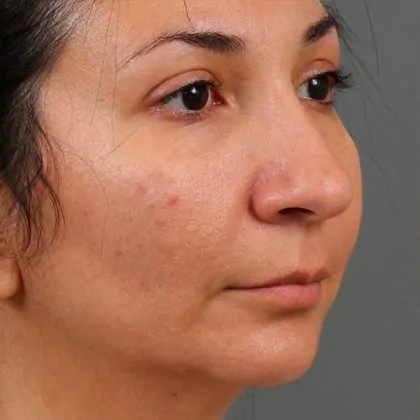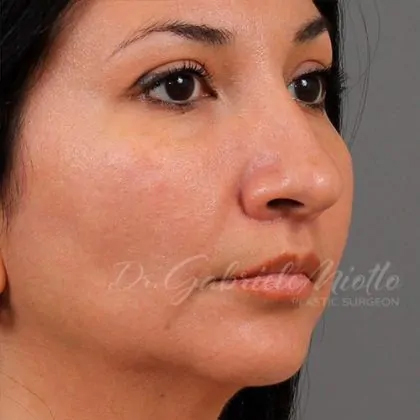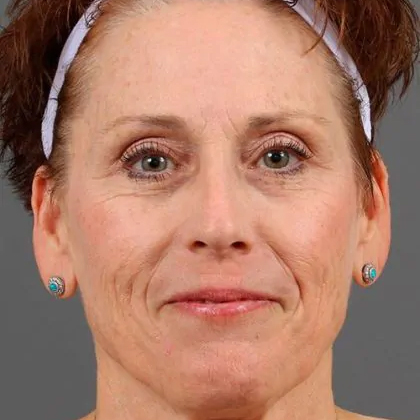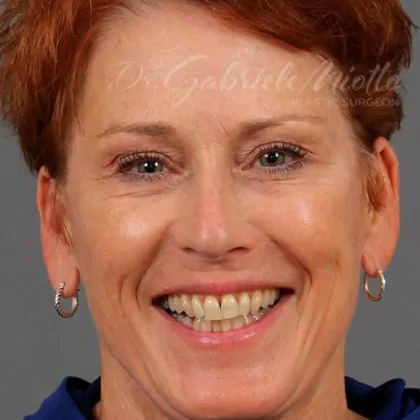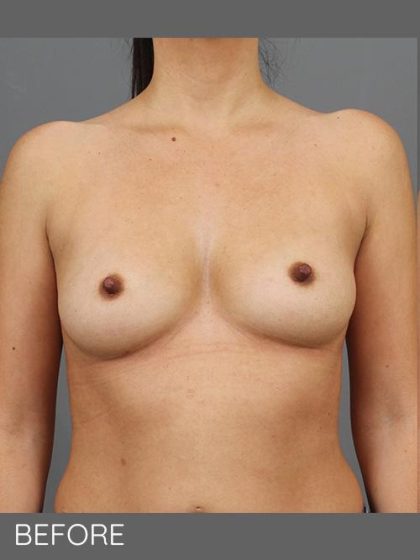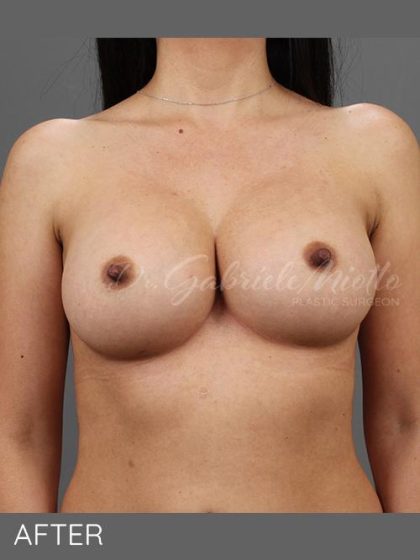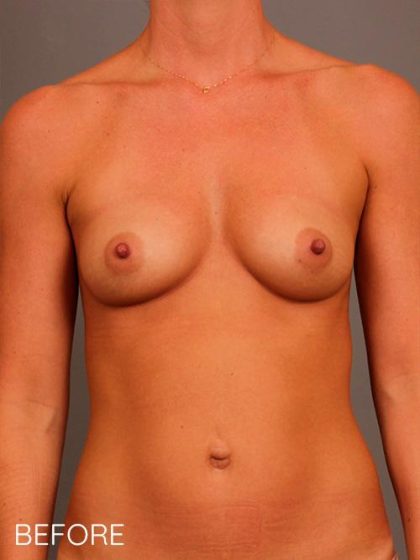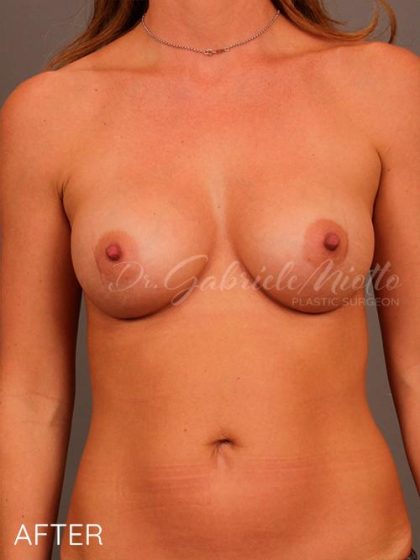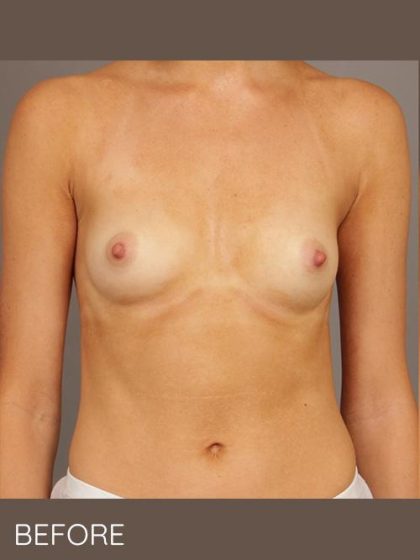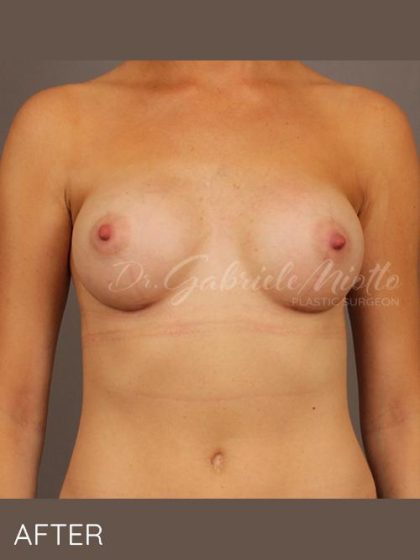Breast Augmentation
Conveniently located to serve the areas of Atlanta, GA

Breast augmentation is one of the most popular procedures in plastic surgery. If someone is looking to improve the shape of their breasts, increase the size of the breasts, or have had a breast reduction in the past and desire more volume, a breast augmentation can make a real and lasting change.
Breast augmentation surgery is done on an outpatient basis and patients can return home the same day.
Contents
- 1 Before and After Photos
- 2 After the procedure
- 3 General recommendations
- 4 Specialist
- 5 Breast Augmentation Candidates
- 6 Ideal for Enhancement
- 7 Surgical Options
- 8 Breast Implant Options
- 8.1 An Implant Can Consist of Silicone or Saline
- 8.2 The Plastic Surgeon Helps the Patient Determine Breast Implant Size
- 8.3 Projection
- 8.4 Breast Implant Shape
- 8.5 The Shell of the Breast Implant
- 8.6 The Location of the Breast Augmentation Incisions
- 8.7 Breast Implant Placement — Over or Under the Pectoral Muscle
- 8.8 Implant placement options
- 9 Consultation
- 10 Choosing Breast Implants
- 11 Surgeon’s Considerations
- 12 How a Patient’s Age Affects Her Breast Implant Options
- 13 Patient Registration Essentials
- 13.1 Medical history
- 13.2 Current medications, herbs and vitamins
- 13.3 Review Dr. Miotto’s list of medications
- 13.4 Nicotine use
- 13.5 Alcohol use
- 13.6 Recreational drug use
- 13.7 Preparing for a Breast Augmentation
- 13.8 Go shopping for food and new tops
- 13.9 Set aside a weeks-worth of clothing
- 13.10 Complete housework
- 13.11 Patients need a driver and a caregiver
- 13.12 Complete Lab Tests at Least a Week Before the Augmentation Mammoplasty
- 13.13 Pick-Up Prescription Medications and Supplements
- 14 The Procedure
- 15 Anesthesia
- 16 Procedure Day Details
- 17 What to Expect
- 18 Results
- 19 FAQ
- 19.1 Can I drive myself home after my breast augmentation?
- 19.2 After my breast augmentation; should I wear a surgical bra?
- 19.3 After my breast augmentation, how long will I need to sleep on my back?
- 19.4 What happens if a breast implant ruptures?
- 19.5 Can I properly care for my toddler after breast augmentation?
- 19.6 How is a breast augmentation surgery performed?
- 19.7 What is breast augmentation with fat transfer?
- 19.8 What is breast augmentation and lift?
- 19.9 Do I need to be sedated during a breast augmentation?
- 19.10 Is breast augmentation painful?
- 19.11 How long will a breast augmentation last?
- 19.12 Will there be visible scars after the breast augmentation surgery?
- 19.13 Will there be swelling after breast augmentation surgery?
- 19.14 What is breast augmentation recovery time?
- 19.15 How much does breast augmentation cost?
- 19.16 Am I a good candidate for breast augmentation?
- 19.17 How can I get started to learn more?
Before and After Photos
After the procedure
Breast augmentation is an outpatient surgery done deep sedation or local anesthesia. After the procedure, there will be tape over the incisions, some bruising and swelling.
Breast augmentation is not a painful procedure, but mild discomfort and feeling of tightness in the area are expected for a few days to a few weeks after surgery. Bruising and swelling are usually the cause of the discomfort. However, it can be treated with preoperative and postoperative medication and supplementation, and anti-inflammatories. Swelling can be minimal or more intense depending on how many procedures need to be done in surgery to make the results the most beautiful and natural possible. There are no sutures to be removed. Return to normal daily activities between 1-2 weeks.
General recommendations
What to avoid before surgery
- DO NOT take any aspirin for 7-10 days before your scheduled procedure. Do not take NSAIDS (Aleve, Motrin, Ibuprofen) for 5 days before surgery. You may take Tylenol (Acetaminophen) if needed for aches or pains. Please contact the office at if you have any questions about any medications that you are taking or if you are prescribed aspirin by your cardiologist or Primary Care Provider (PCP).
- Discontinue Vitamin E 10 days before surgery.
- Avoid the following herbal supplements for 10 days before surgery: Echinacea, Ephedra / Phentermine (used for weight loss), Feverfew, Fish Oils, Garlic, Ginkgo Biloba, Goldenseal, Kava-Kava, Licorice, Saw Palmetto, St. John’s Wort and Valerian.
- Stop Smoking. The harmful effects of smoking can cause tissue death, infection, and open wounds. It also makes you age faster!
- Alcohol can promote swelling of the surgical area and it is best to avoid alcohol intake for at least one week before surgery.
What to take before surgery
- Dr Miotto will prescribe medication and supplements to help with your recovery and speed up healing.
General postoperative recommendations
- You MUST have a responsible adult to transport you home and stay with you for a full twenty-four hours after your surgery.
- You will be unable to drive if you are taking narcotics.
- It is common to feel sluggish for a few days as the anesthesia works its way out of your system.
- Your initial post-operative appointment will be scheduled by your Patient Care Coordinator.
Activity
- For your safety, we require that you have a responsible adult stay with you for twenty-four hours after your surgery for general help, as you may find your balance and judgement impaired.
- Please refrain from physical activity that will increase your heart rate or blood pressure for 2 weeks after surgery. However, bed rest is NOT recommended, and you should be walking at normal pace after the procedure.
- Frequent walking will decrease the risk of post-operative blood clots (mostly after general anesthesia).
- Sexual activity can safely be resumed 2 weeks following surgery. Please discuss with Dr Miotto as needed.
Bathing
- You can shower twenty-four hours after surgery. Maintain the tape on the incisions.
- Do not submerge yourself into a tub/pool until all wounds have healed (usually in 3 weeks).
- Do not scrub the surgical sites, however you can allow soapy water to run over them.
- Avoid lotions on the surgical sites for 2 weeks, but you can moisturize any other areas as desired.
Returning to Work
- Recovery time will vary; however, most patients return to work within 1- 2 weeks after the procedure, within one week you will have a feel for your specific limitations and will be able to determine how comfortable you will be with resuming your daily activities and workload.
Diet
- Immediately following surgery, it is best to eat bland, easily-digested food and avoid excess sugar and salt. Healthy proteins (eggs, lean meat, beans, nuts), rice, fruits and cooked vegetables (broccoli, peppers, sweet potatoes) will provide your body with nutrients essential for healing.
- Eat a few bites of food before taking pain medications as these can cause nausea.
- A diet low in sodium will help minimize swelling and water retention.
- Drink plenty of water! Drinking low sugar sports drinks and protein shakes are recommended.
Final Results
- Keep in mind that our goal in aesthetic surgery is improvement and not perfection. You will be followed closely after surgery to assure that you heal well and have the best possible results.
Specialist
A breast augmentation (augmentation mammoplasty) is a surgical procedure that plastic surgeons use to increase the size and improve the shape of a woman’s breasts. Some women choose to have an augmentation mammoplasty to increase the size of their breasts and improve their self-confidence level. Other women decide to have an augmentation mammoplasty to address breast irregularities such as tubular breast deformity or breast changes resulting from trauma. In addition, a breast augmentation is a component of reconstruction treatment following a mastectomy. At ME Plastic Surgery, Dr. Gabriele Miotto performs augmentation mammoplasties to help women attain the beautiful, symmetrical and more voluptuous breasts they desire.
Breast Augmentation Candidates
Many of the women who choose to have an augmentation mammoplasty are fulfilling their desire for larger, more voluptuous breasts. These women may feel as if their breasts are too small. Some women choose to have a breast augmentation to rejuvenate their breasts following a pregnancy, breastfeeding or after losing a significant amount of weight.
Ideal for Enhancement
- Have difficulty finding swimsuits, braziers and tops that properly fit their chest.
- Would like their upper and lower body to be more proportionate.
- Are unhappy with the shape of their breasts (e.g., their breasts look tubular).
- Have breasts that look deflated.
- Are unhappy because their breasts are asymmetrical.
Benefits
An augmentation mammoplasty provides women with a way to address a variety of breast issues that they find bothersome.
Augmentation mammoplasty
- Address breast variances related to the size of a woman’s breasts. For example, during an augmentation mammoplasty, Dr. Miotto addresses breast asymmetry by using a breast implant to increase the size of the smaller breast. The implant size the surgeon chooses provides the patient with the symmetrical breasts she desires.
- Increase the size of a woman’s breasts who thinks her breasts are too small.
- Use an augmentation mammoplasty as a component of breast reconstruction treatment following a mastectomy.
- Increase the size of a woman’s breasts when she has lost volume due to significant weight loss, pregnancy or breastfeeding.
- Address visual irregularities in the breast resulting from trauma, tubular breast deformity or other issues that affect the size and shape of the breast.
Before an augmentation mammoplasty, the patient, and her plastic surgeon discuss the different aspects of an Atlanta breast augmentation. Subjects the surgeon discusses include the patient’s surgical options.
Surgical Options
During the initial consultation, Dr. Gabriele Miotto listens to the patient’s concerns about her breasts and then asks about her goals. The information Dr. Miotto gathers during the consultation helps the surgeon determine which augmentation mammoplasty options will serve a patient best.
Dr. Gabriele C. Miotto is a Brazillian-American plastic surgeon specialized in aesthetic surgery and minimally invasive procedures, specially of the face, eyes, nose, breast and liposuction. Call (404) 850-5851 for your consultation.
Breast Implant Options
An Implant Can Consist of Silicone or Saline
Both saline and silicone breast implants can provide a patient with beautiful, voluptuous breasts. Nonetheless, there are differences between these two types of implants. The saline implant provides patients with rounder, fuller-looking breasts. The silicone implant offers patients a breast that feels softer and looks more natural than can be accomplished with its saline counterpart.
The Plastic Surgeon Helps the Patient Determine Breast Implant Size
The surgeon helps patients as they contemplate what size they would like their implants to be. Dr. Gabriele Miotto recommends an implant size that should fulfill the patient’s desires.
Projection
The projection of a breast implant refers to how far the implant extends forward from the patient’s chest.
Breast Implant Shape
Breast implants can be round or anatomical (i.e., shaped like a teardrop).
The Shell of the Breast Implant
The implant’s shell can be textured or smooth.
The Location of the Breast Augmentation Incisions
Sometimes the type of implant dictates the best location for the incision. Nonetheless, despite the incision’s location, Dr. Miotto has the artistic vision and exceptional surgical skill to ensure the resulting scar is well hidden within the natural folds of the breast, armpit or around the edge of the nipple-areolar complex.
When the surgeon creates an axillary incision, it is in the underarm area. With an axillary incision, there is no scarring on the patient’s breasts.
The inframammary incision is hidden within the crease at the base of the breast.
When the surgeon creates a periareolar incision, the edge of the nipple-areolar complex serves as the means to camouflage the incision.
Breast Implant Placement — Over or Under the Pectoral Muscle
Prior to placing a breast implant, the surgeon creates a pocket in which the implant rests. The surgeon can create this pocket above or below the pectoral muscle.
Implant placement options
- To place an implant subglandularly, the surgeon creates a pocket above the pectoral muscle, but beneath the skin, fat and glandular tissue of the breast.
- To place a breast implant submuscularly, the plastic surgeon creates a pocket for the implant beneath the skin, fat and glandular tissue of the breast, and the pectoral muscle.
Consultation
Many of Dr. Gabriele Miotto’s patients have a good idea as to what they would like to accomplish with an augmentation mammoplasty. Nonetheless, Dr. Miotto is always happy to make recommendations. Any recommendations she makes are aimed at providing the patient with the best results possible. Patients should never feel obligated to have a procedure just because Dr. Gabriele Miotto recommends it.
Once Dr. Miotto knows what the patient would like to accomplish with an Atlanta augmentation mammoplasty, she provides the patient with detailed information about the breast augmentation procedure. Topics the surgeon and patient discuss include breast implant characteristics (e.g., size, type, shape), incision options (i.e., periareolar, inframammary or axillary) and placement location (i.e., above or below the pectoral muscle).
At their initial consultation with Dr. Gabriele Miotto, patients need to be able to describe what characteristics they would like their breasts to have after their augmentation mammoplasty. The surgeon needs to know how the patient would like her breasts to look and feel.
In reference to breast size and overall appearance, some patients find it helpful to bring in a photo that represents the way they would like their breasts to look.
Another way patients can better express their desires is by reviewing ME Plastic Surgery’s breast augmentation before and after photos to find breasts that resemble the way they would like their breasts to look.
Choosing Breast Implants
During this consultation, patients may have the opportunity to touch and try on implants of various sizes.
The surgeon uses the information the patient provides to narrow down the patient’s choices.
Surgeon’s Considerations
- The patient’s current breast size and the increase she desires.
- The patient’s age.
- What the patient wants her breasts to look like after her breast augmentation in Atlanta.
- The patient’s personal preferences in relation to implant type.
- Whether the patient is having a combination procedure or not. For example, many patients decide to have a breast lift and augmentation mammoplasty during the same surgical session. During a breast lift, the surgeon rejuvenates the patient’s breasts by moving them to a more youthful position on her chest and an augmentation mammoplasty to increase the size of the patient’s breasts.
How a Patient’s Age Affects Her Breast Implant Options
The Federal Drug Administration (FDA) has set guidelines that plastic surgeons must follow in relation to breast implants. Age plays a role in the FDA’s guidelines.
Saline breast implants are FDA approved for individuals who are at least 18 years of age. Silicone breast implants are FDA approved for individuals who are at least 22 years of age.
Patient Registration Essentials
Medical history
Dr. Miotto needs to know about previous surgical procedures, treatments and whether the patient has any chronic conditions. She also needs to know if the patient has an allergy to latex or particular medications. Furthermore, since the patient is considering a breast augmentation, Dr. Miotto also wants to know if breast cancer runs in the patient’s family. In addition, the patient needs to inform the surgeon if she has ever had breast cancer herself or has had any type of surgical procedure on her breasts.
If the patient has routine mammograms, Dr. Gabriele Miotto needs to know when she had her last mammogram. The patient should bring the written report that details the results of her most recent mammogram to the initial consultation for a breast augmentation in Atlanta.
Current medications, herbs and vitamins
The plastic surgeon needs this information to ensure that the patient is not taking anything that increases the likelihood of her experiencing excessive bleeding during or after surgery. Some products that are known to thin the blood include aspirin, non-steroidal anti-inflammatory drugs (NSAIDs), vitamin E and herbs like Ginkgo Biloba. If the patient needs to take medication for pain relatively close to the date of her surgery, it is safe for her to take non-aspirin.
- Aspirin needs to be avoided for 10 days before the augmentation mammoplasty.
- NSAIDs must be avoided for 5 days before surgery.
- Vitamin E needs to be avoided for 10 days before the patient’s surgery.
- Herbal supplements like Ginkgo Biloba must be avoided at least 10 days before surgery.
Review Dr. Miotto’s list of medications
Before surgery, patients should review the list explaining which products to avoid. This list also includes information about how long these products need to be avoided before and after a breast augmentation in Atlanta.
Nicotine use
Patients who use products that have nicotine in them (e.g., cigarettes, e-cigarettes, smoking cessation products) need to stop using these products for the 4 weeks leading up to their augmentation mammoplasty and the 4 weeks after their breast augmentation. Nicotine is a vasoconstrictor, which means it causes the walls of the blood vessels to contract. These contractions interrupt the blood flow, negatively affecting the healing process. Continuing to use these products can cause slow healing, resulting in an infection and necrosis (i.e., tissue death).
Alcohol use
Since alcohol increases inflammation, patients have to avoid drinking alcohol for the 7 days leading up to their augmentation mammoplasty.
Recreational drug use
To ensure their own safety, patients must let their surgeon know if they participate in recreational drug use.
Preparing for a Breast Augmentation
Dr. Gabriele Miotto may request that the patient have a baseline mammogram before her surgery. Patients may have other lab tests to complete before their augmentation mammoplasty as well.
Dr. Miotto may need to adjust or ask the prescribing physician to adjust some of the patient’s medication.
Go shopping for food and new tops
Take some time before surgery to go shopping, purchase foods that are healthy and easy to cook.
Patients need to remember to purchase shirts that button-up or snap in the front. In addition, to accommodate her newly enlarged breasts, these shirts should be larger than the shirts the patient usually wears.
Set aside a weeks-worth of clothing
Patients should set aside comfortable clothing to wear for the week following their augmentation mammoplasty. The tops must button or snap in front, and the bottoms should be easy to put on and take off.
After creating her day-to-day wardrobe, the patient needs to place these clothes in an area that does not require her to reach or lift her arms.
Complete housework
Since the patient will need some time to recover; she needs to complete her housework before the day of her breast augmentation.
Patients need a driver and a caregiver
During a breast augmentation, the patient receives anesthesia. After receiving twilight or general anesthesia, an individual is unable to drive for 24 hours. As such, on the day she is having her surgery, the patient needs to bring a capable driver with her. A capable driver is someone who can assist the patient as she walks into her home after surgery. A patient who arrives without her driver will be unable to have her surgery.
Patients also need to have a caregiver remain with them for the 24 hours following their surgery. The person the patient chooses to serve as her caregiver must be someone that she trusts and feels comfortable with. Since the caregiver may need to help the patient walk to the washroom, the person caring for the patient must be capable of performing this task.
Complete Lab Tests at Least a Week Before the Augmentation Mammoplasty
To ensure that Dr. Miotto receives the patient’s test results in time for her surgery, the patient must complete the tests at least a week before her scheduled surgery. Not having these results could delay the patient’s breast augmentation.
Pick-Up Prescription Medications and Supplements
Before surgery, Dr. Miotto prescribes medication and supplements for the patient to take following surgery. These help the patient as she recovers and also speeds up the healing process. Patients should purchase these products ahead of time so that they will be readily available upon returning home after their augmentation mammoplasty.
The Procedure
The night before her augmentation mammoplasty, the patient needs to fast. The time to start fasting depends on the time of the surgery. Dr. Gabriele Miotto provides the patient with her fasting information.
An augmentation mammoplasty in Atlanta is an outpatient procedure that takes approximately an hour to complete.
On the day of surgery, patients need to wear clothes that are easy to take off and to put on. The top the patient wears must either button or snap in the front because she has to avoid wearing tops that need to be lifted over her head for some time as she recovers. This top must also be larger than the tops she usually wears; otherwise, it will be unable to accommodate her newly enlarged breasts.
Anesthesia
Before the surgery begins, the patient receives either twilight or general anesthesia.
With twilight anesthesia, the patient receives local anesthesia, which numbs the area where Dr. Miotto makes the incision, and sedation, which helps the patient remain in a light sleep throughout her augmentation mammoplasty. General anesthesia causes the patient to fall into a deeper sleep.
Before the patient’s breast augmentation, Dr. Gabriele Miotto discusses the anesthesia options with the patient and recommends the anesthesia that she believes will serve the patient best.
Procedure Day Details
The patient begins the day of her procedure in the pre-op area. Dr. Miotto typically visits the patient here. During this visit, she makes markings on the patient’s breasts. Dr. Gabriele Miotto uses these markings as guides throughout the patient’s surgery.
Once the patient receives anesthesia, the augmentation mammoplasty begins.
After the patient falls asleep, Dr. Miotto carefully creates the previously agreed upon incision (i.e., inframammary, axillary or periareolar).
Now, she creates the pocket that holds the patient’s breast implant. Dr. Gabriele Miotto creates this pocket by separating the breast tissue from the muscles and the connective tissue within the patient’s chest. Dr. Miotto can create this pocket either under the breast tissue, but above the pectoral muscle (subglandular) or under both the breast tissue and the pectoral muscle (subpectoral).
If the patient chooses saline implants, Dr. Miotto fills the implant’s shell with sterile saline after she places it within the pocket.
Since the silicone breast implant arrives prefilled, Dr. Gabriele Miotto simply places this implant directly into its pocket.
Once she centers the implants behind the patient’s nipples, and she is happy with the way her patient’s breasts look, Dr. Miotto uses sutures and gently closes the incisions.
After closing the incisions, Dr. Gabriele Miotto bandages the incision using skin adhesive and surgical tape.
In addition, the patient may receive a compression garment to wear as she recovers.
What to Expect
Directly following surgery, patients remain in the recovery room until they awaken. Once the patient is awake and coherent, she receives information related to her recovery. After answering any questions the patient has, Dr. Gabriele Miotto releases the patient to her driver.
To reduce the likelihood of complications, follow dr. Miotto’s instructions
Following the instructions that the plastic surgeon provides about restrictions and returning to work is vital to ensuring the patient receives optimal results. For at least 14 days after surgery, the patient must avoid performing activities that will increase her heart rate or elevate her blood pressure. However, Dr. Miotto does not recommend bed rest. Patients need to remain somewhat active. Taking short walks at a normal pace throughout the day is beneficial to the healing process and helps prevent the development of blood clots. Post-operative blood clots are typically a concern following general anesthesia, not twilight.
Personal hygiene following an augmentation mammoplasty
Once the patient reaches the 24-hour mark, she can shower. However, she needs to be careful so that the tape remains on her incisions.
While showering, it is okay to have soapy water run over the surgical sites, but refrain from scrubbing these sites.
Patients must avoid submerging themselves in bathtubs, pools, hot tubs or any other body of water until all their wounds heal completely, which usually takes about 3 weeks.
It is okay for the patient to apply lotion to other areas of her body; however, she should not apply lotions to the surgical sites for 2 weeks.
Recovering from an Augmentation Mammoplasty
Patients should expect their breasts to be tender. Soreness, inflammation and bruising are likely. These side effects usually continue for a few weeks.
Any scars resulting from an augmentation mammoplasty should fade with time; however, these scars will always be slightly visible.
Follow Dr. Miotto’s instructions relating to wearing the compression bandage or sports bra.
For the first 48 hours after surgery, in order to keep inflammation down and reduce pain, patients need to sleep in an upright position. One of the best places to sleep during this early stage of recovery is in a recliner.
It is vital that patients avoid participating in strenuous activities for at least 2 weeks (possibly 3) after their augmentation mammoplasty. Patients must avoid lifting heavy objects and performing exercises until Dr. Miotto releases them to do so.
Most patients can participate in sexual activity 2 weeks after their breast augmentation; nonetheless, patients should verify that it is okay with Dr. Miotto ahead of time.
Patients who have breast augmentations and work sedentary jobs often return to work within a week or two of their surgery.
After 8 weeks of recovery, most patients can return to their normal activity levels.
Results
It takes several weeks for the inflammation to subside, but once it does, patients have a clearer picture in relation to their final results.
A combination procedure to rejuvenate and enlarge the breasts
If a breast augmentation patient has breasts that sag, Dr. Gabriele Miotto can address this issue at the same time she increases the size of the patient’s breasts.
Potential risks associated with an augmentation mammoplasty
All surgeries carry with them potential risks and complications. Although many of these issues are rare when an experienced plastic surgeon performs the augmentation mammoplasty, the possibility must always be considered.
Potential risks and complications of a breast augmentation include:
- Chronic breast pain.
- Infection.
- Necrosis.
- Breast-implant illness.
- Implant movement within the breast.
- Changes in the sensation of the nipple.
- A leaking or ruptured implant.
- Changes in the sensation of the breast.
- The development of excess scar tissue, resulting in a misshapen breast (i.e., capsular contracture).
- A very low increase in the risk of a woman developing Breast Implant-Associated Anaplastic Large Cell Lymphoma. The only women whose risk increases are those who receive textured implants.
Some of these complications do require that the patient have another surgical procedure.
As a female plastic surgeon, Dr. Gabriele Miotto offers her breast augmentation patients a unique perspective that only a woman can provide. Dr. Miotto dedicates herself to helping each patient achieve the breast shape and size that she desires. If you are interested in discussing the various augmentation mammoplasty options available in Atlanta, contact ME Plastic Surgery to schedule an appointment with top Cosmetic and Breast Augmentation Surgeon, Dr. Gabriele Miotto. To schedule an appointment by phone, please call (404) 850-5851. To contact the office or request an appointment with an online form, please click here. ME Plastic Surgery is located at 3200 Downwood Circle, NW, Suite 640.
FAQ
Can I drive myself home after my breast augmentation?
So when patients have a breast augmentation surgery, it’s always done under local with sedation or general anesthesia. So everybody needs to have a adult driver to take them home because of the effects of anesthesia and also the strong pain pills or injection that they take during surgery. So you can cannot drive for 24 hours for sure, but you can drive if you don’t need to take strong pain medications after the first day of surgery.
After my breast augmentation; should I wear a surgical bra?
We recommend that the patients use a post surgical bra after breast augmentation for about four to six weeks. That’s the period that the most intense healing is happening and also that most of the swelling is going down. So a sports bra or a surgical bra that fits the patient well, is not supertight, is not a super loose either, it needs to be comfortable and firm. That will help us keep the breast tissue and the implant stable, it will help also control a little bit of the swelling. It will not change the results of your breast augmentation, but it will help you go through this early recovery phase in a very comfortable way and safe way. So that’s why we recommend it for four to six weeks.
After my breast augmentation, how long will I need to sleep on my back?
Usually after a breast augmentation surgery, we do recommend that the patient sleep on their back for four to six weeks after surgery. It will be okay to sleep on the side after the first week, but what we don’t want is the compression directly on the implant, which will force it towards the scar. So we could have an incision opening, so an open wound, or we can have a widening of the scar if we start putting pressure on that breast a little bit too early. And also, we could also have bleeding. So I’ll tell my patients, you can sleep on your back sometimes with the head a little bit elevated so all the swelling comes down as the patient is healing. It’s nice to sleep with a light post surgical bra or a light sports bra to give that sense of security and also to also improve a little bit of the swelling. But really sleeping on your stomach, I would say only after six weeks of surgery.
What happens if a breast implant ruptures?
So if a breast implant ruptures, which is very rare, what happens is for the cohesive silicone gel or gummy bear gels, the implants I use, they will actually have a tear there. But it doesn’t leak, it kind of comes in, the tear is there, right? So the shell can flip around, but even if it is open, it doesn’t leak out. It kind of comes in and out and stays around the implant. So usually when we remove ruptured implants, what we see is this gel that is kind of stable and sticky around the breast tissue, but contained into a pocket. So it doesn’t go anywhere. It stays where the implant is. And this is basically what it looks like when we remove it. But you can see if the tear is there and the implant is ruptured, it doesn’t leak. Right? It just it stays inside the breast implant, it’s right there and it stays glued to the shell. So this is a very nice thing about the modern breast implant, they do not leak anymore.
Can I properly care for my toddler after breast augmentation?
After a breast augmentation surgery, we recommend that the patients do not use their arms to do heavy weight lifting or intense activities for about two to four weeks. So if a patient has a young child and needs to be picked up from the floor or the crib, we would recommend that they don’t do that the first week, sometimes even two weeks after surgery. They can have the child come on their lap or when they are sitting, but the picking up of a lot of weight can actually cause bleeding sometimes and can also affect the healing in a negative way. So we would recommend just taking it easy those first two weeks, including picking up your child or having to carry heavy weight during those two weeks.
How is a breast augmentation surgery performed?
Breast augmentation surgery is performed under deep sedation or general anesthesia. We start with small incisions, usually in the fold under the breasts and create space under the breast (subglandular) or under the muscle (subpectoral) to place the implants.
During the procedure we add implants for patients seeking a larger or different shaped breast. We carefully close and suture the skin. The procedure takes about 1 hour to complete, and patients can go home the same day. For those patients looking to reduce the size of their breasts, we will remove excess sagging tissue and perform a breast lift at this time.
What is breast augmentation with fat transfer?
Fat transfer is a common cosmetic surgery procedure to add moderate volume and size to the breast. We remove fat with liposuction from any body part with fatty deposits such as the abdomen, legs and arms, and it is transferred with special cannulas to the areas of the breast we want to enhance. For patients desiring a larger breast change, more firm breasts, a breast augmentation surgery with implants is suggested.
If you would like to discuss the different options for breast augmentation and types of implants we recommend, I would be pleased to meet you for a consultation to answer any questions you have. Dr. Gabriele Miotto, Cosmetic and Breast augmentation Surgeon in Atlanta.
What is breast augmentation and lift?
A breast augmentation is sometimes combined with a breast lift when we need to remove excess skin and lift the breasts to reduce sagging.
Do I need to be sedated during a breast augmentation?
Breast augmentation surgery is done with deep sedation or with general anesthesia. These options are discussed with the patient once the type of procedure is decided on.
Is breast augmentation painful?
There is no pain during the surgery as we numb all of the areas of the breasts where we will be working. Patients may feel some mild pain after the surgery from any bruising or swelling, but there will be prescriptions given for pain and discomfort.
How long will a breast augmentation last?
A breast augmentation is a permanent change, however, breast implants will need to be exchanged at a later date. My patients enjoy a beautiful result for many years.
Will there be visible scars after the breast augmentation surgery?
In general, scars should not be visible since they are in the fold under the breasts or in the axilla. Incisions usually heal really well and become a thin line.
Will there be swelling after breast augmentation surgery?
Yes, there will be some bruising and swelling after the surgery for about a week. Some swelling and discomfort may continue for another 1-2 weeks. We recommend wearing a bra to help support the breasts.
What is breast augmentation recovery time?
The average downtime is about 2 weeks after the procedure. Most patients feel really well after about 2 weeks and can return to their normal activities. Depending on the type of procedure, some patients have more swelling or bruising than others. In 4-6 weeks, patients are usually able to return to more intense physical activities such as going to the gym. Patients will need to return to the office to have follow-up checks, but there are no sutures to be removed.
How much does breast augmentation cost?
There are several factors which make up the cost of breast augmentation. It varies depending on the goals of the patient, the type of implant, and the complexity of the procedure.
Am I a good candidate for breast augmentation?
You may be a good candidate for a breast augmentation if you want larger, fuller breasts and better breast cleavage.
How can I get started to learn more?
If you are interested in breast augmentation to enlarge your breast size, come see us in the office for an in-person consultation. We can talk about what you want to achieve, ideal implant size and shape for your body, and I will answer any questions you have.


